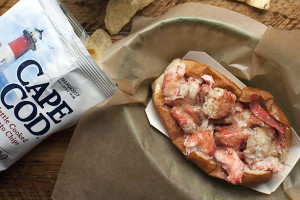Welcome to the New Golden Age of the Oyster
There's never been a better time to be an oyster farmer, but according to some of New England's leading shellfish authorities, that auspicious window could be closing fast.
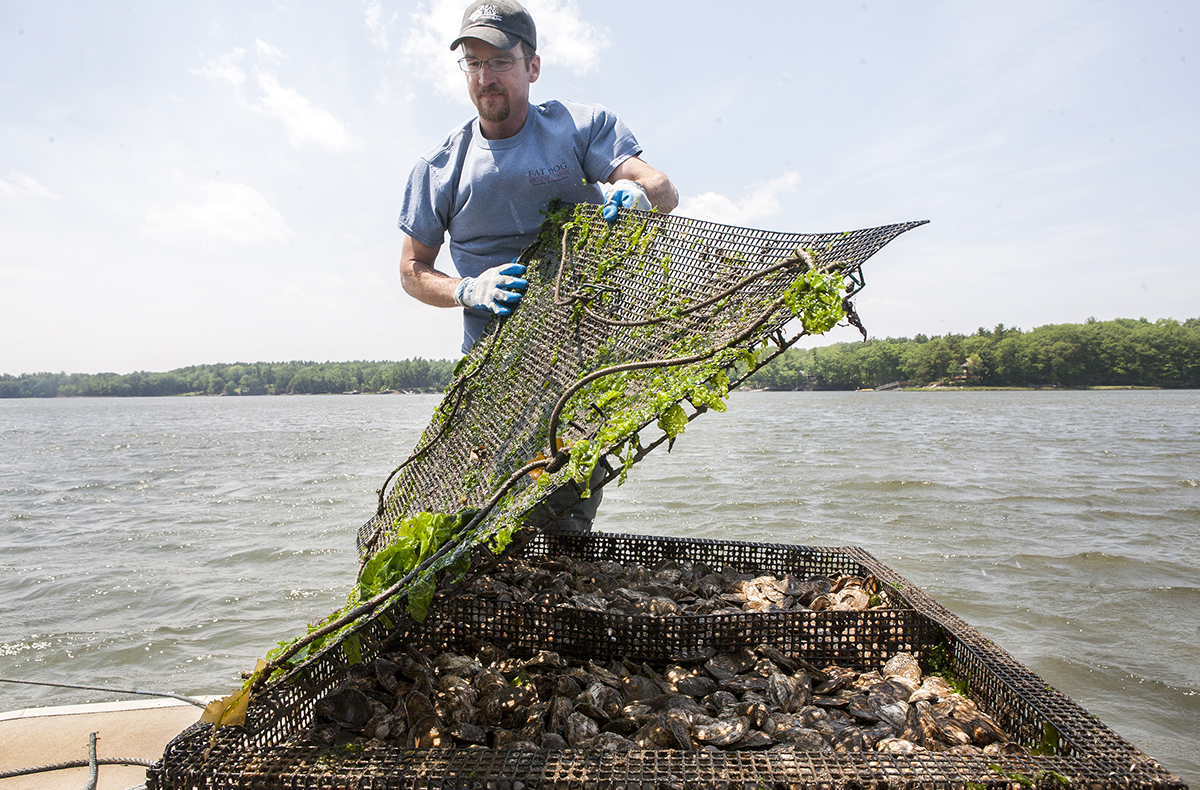
Jay Baker of Fat Dog Shellfish Company. Photo by Olga Khvan.
If it feels like every buzzy new restaurant, every swanky has-been, every sports bar, every ersatz Irish pub, every once-proud neighborhood destination, and hell, even every greasy clam shack is jumping aboard the raw bar trend—you’re not far off. These days, any eatery looking for the culinary equivalent of a B-12 shot is turning to the increasing allure of the oyster. And it’s working.
We’re now living in what Island Creek Oysters founder and owner Skip Bennett likes to call “America’s oyster renaissance.” Yes, this still nascent golden age might pale in comparison to the country’s peak bivalve-consuming epoch in the early 1900s, when hauls of eastern oysters reached 27 million bushels a year. But for the first time since the 1950s, when shellfish parasites MSX and Dermo wiped out large swaths of the oyster population along the Mid-Atlantic, the industry is thriving.
On the supply end, aquaculture has become a veritable gold rush, with restaurants now paying upwards of $1 per oyster, and according to Robert Rheault, executive director of the East Coast Shellfish Growers Association (ECSGA), up to $6 an oyster in seafood-mad Singapore. That kind of financial reward is inspiring a lot of career change as first-time oyster farmers are appearing in droves, scrounging for any available acreage among the increasingly crowded coastline.
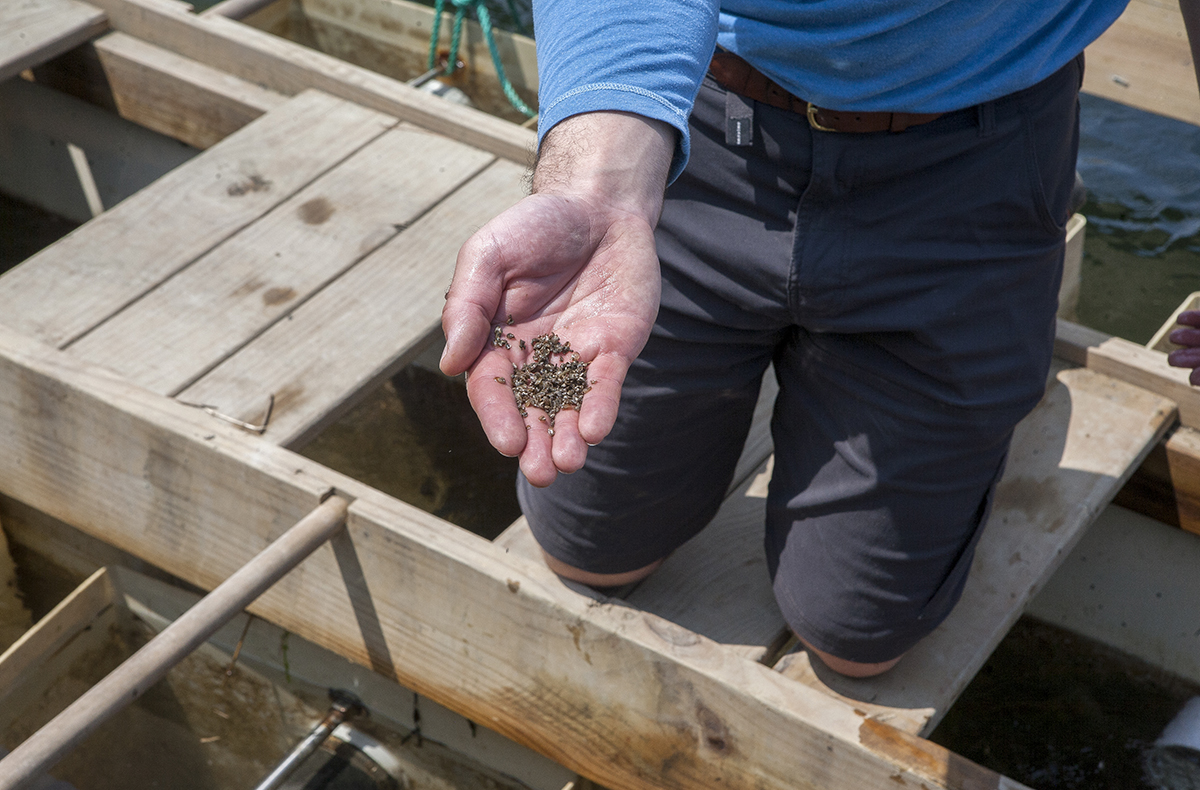
Young, thumbnail-sized oysters being raised in upwellers. Photo by Olga Khvan.
Back in the mid-1990s, when Skip Bennett switched his company’s focus from clams to its bivalve brethren, the oyster, there were only handfuls of commercial oyster farmers in New England. Now, the ECSGA estimates there are more than 500 outfits cultivating bottom leases up and down the Northeastern seaboard. Rheault, who also owns Narragansett’s Moonstone Oysters, is one of the early pioneers of this now booming sect. He can remember the gritty early days of the late-’80s when it was a struggle to offload his weekly harvest. Now there’s a global bidding war for his product.
“I’ve had a doubling of production over the last five years, and the price continues to climb at a substantial rate of almost five percent a year,” Rheault says. “That tells me demand is growing even faster. What else has doubled over the last five years? I can’t think of a damn thing. I hear the term ‘renaissance’ a lot and I think it’s an apt description.”
It’s not just lobstermen and fishermen changing career paths either. Scientists, lawyers, and amateurs from all walks of life are testing their mettle among the ocean’s notoriously fickle estuaries. Jay Baker of Fat Dog Shellfish Company in New Hampshire launched his company after years in Massachusetts’ Office of Energy and Environmental Affairs. After being tasked with issues of water quality remediation, bestowing grants to towns and nonprofits to clean up the various marine pollution problems, Baker became familiar with the work of Bennett and other oyster farmers working along the coast. He saw firsthand the soaring oyster prices, and the innate appeal of a life at sea, so he abandoned his government post to gamble on his own venture.
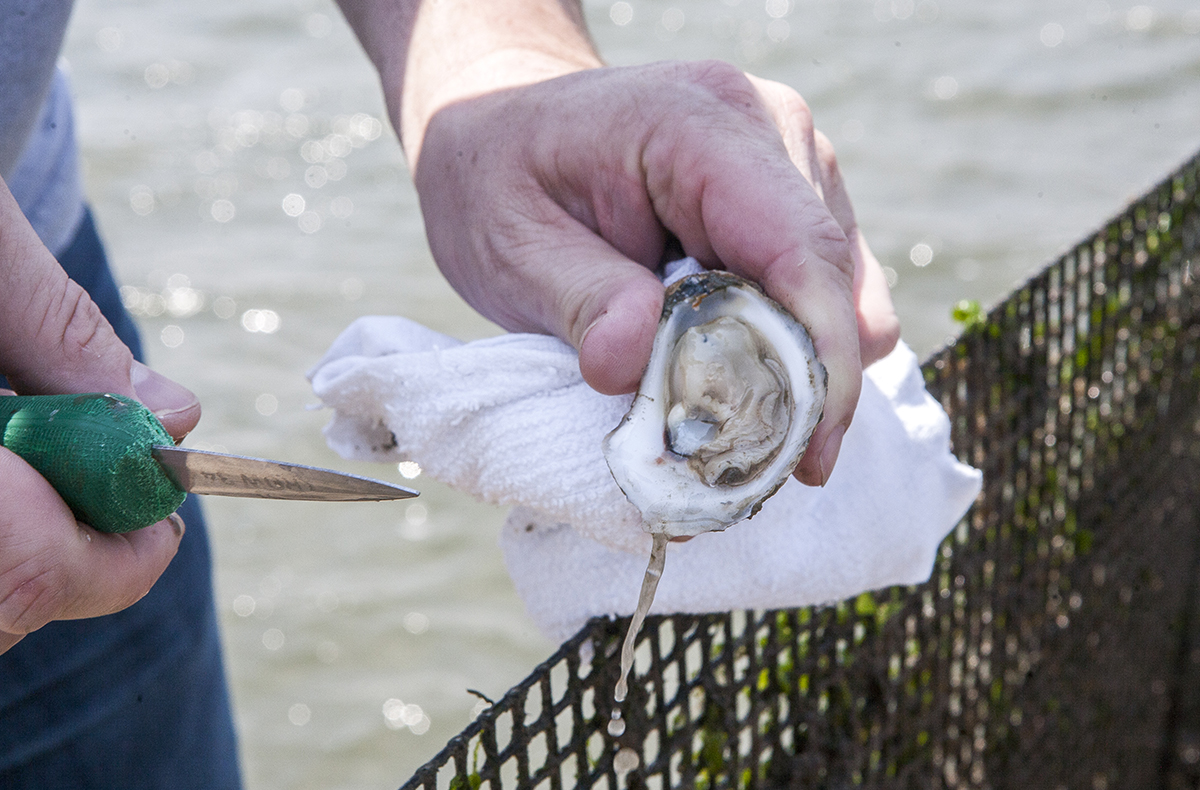
A three-year-old oyster almost ready for harvest. Photo by Olga Khvan.
After searching fruitlessly for available oyster tracts near his North Shore home, Baker lucked out and found eight acres in burgeoning Great Bay, less than 10 miles from Portsmouth. Even with his expertise, Baker’s learning curve was steep. In his first three years of business, Baker lost more than half his crop to predation, exposure to the elements, disease, and even the inherent obstacles of manual harvesting. And according to Baker, those results were fortuitous.
“You can cultivate anywhere between 200,000 to 500,000 oysters per acre, but the real challenge is getting back what you produce,” Baker says. “We budget for much more than half. I always tell first-time farmers, ‘If you’re only losing half your crop, you’re doing spectacular.'”
That damning mortality rate extends itself to more experienced hands like Rheault and Bennett, who often concede more than 60 percent of their annual oyster crop despite the integration of recent “disease-resistant” strands like Rutgers University’s “Haskin NEH.” These pricey larvae, developed through selective breeding, are integral to the entire system due to the continuing presence of MSX and Dermo—one of the reasons why it’s becoming rarer and rarer to ever encounter a wild oyster on a restaurant menu.
In his comprehensive book, The Big Oyster, author Mark Kurlansky documents the heyday of the oyster in New York, when the lower Hudson estuary contained 350 square miles of oyster beds and the New York Harbor alone contained half of the the world’s oyster stock. But with the devastating outbreak of MSX in the 1950s, 95 percent of the country’s wild oyster reefs were decimated, something the industry has yet to recover from.

Ray Grizzle in front of recycled oyster shells donated by Robert’s Maine Grill. Photo by Olga Khvan.
Ray Grizzle, director of marine science at the University of New Hampshire, began restoration efforts with his Oyster Conservationist Program in the late-1990s when New Hampshire was hit with a second wave of MSX, an outbreak that killed off 90 percent of the wild oyster population in Great Bay. After working with New Hampshire Fish and Game, Natural Resources Conservation Services, and the National Oceanic and Atmospheric Administration for more than a decade, Grizzle is still less than optimistic about the future of the wild oyster, at least as a viable food source.
“I think the future, particularly in the Northeast, is going to be more and more consumption of farmed oysters, while the reefs will just be manned for their ecosystem services,” Grizzle says. “We’re just starting to learn how to do this, and we don’t know if it’s going to work or not. We don’t have a silver bullet oyster. They’re still dying young. We’ve had some successes, but we can’t build a reef that will do better than the natural reefs in density and reproduction, and the natural reefs are not doing well. That’s the bottom line.”
Other potential hazards also loom large over the industry. Grizzle points to climate change and the warming of the Atlantic, which is already driving invasive predators like blue crabs and rock crabs up into New England waters. Rheault says he feels “less than sanguine” about rising sea levels and ocean acidification, the changing of the ocean’s seawater chemistry due to the absorption of excess carbon dioxide.
“I hate to be the one to say ‘the sky is falling,’ but the last time we had CO2 levels this high was the Paleocene-Eocene Thermal Maximum 56 million years ago,” Rheault says. “There were global extinctions of a lot of marine species. Even using the term ‘mass extinctions’—that should give everyone pause.”
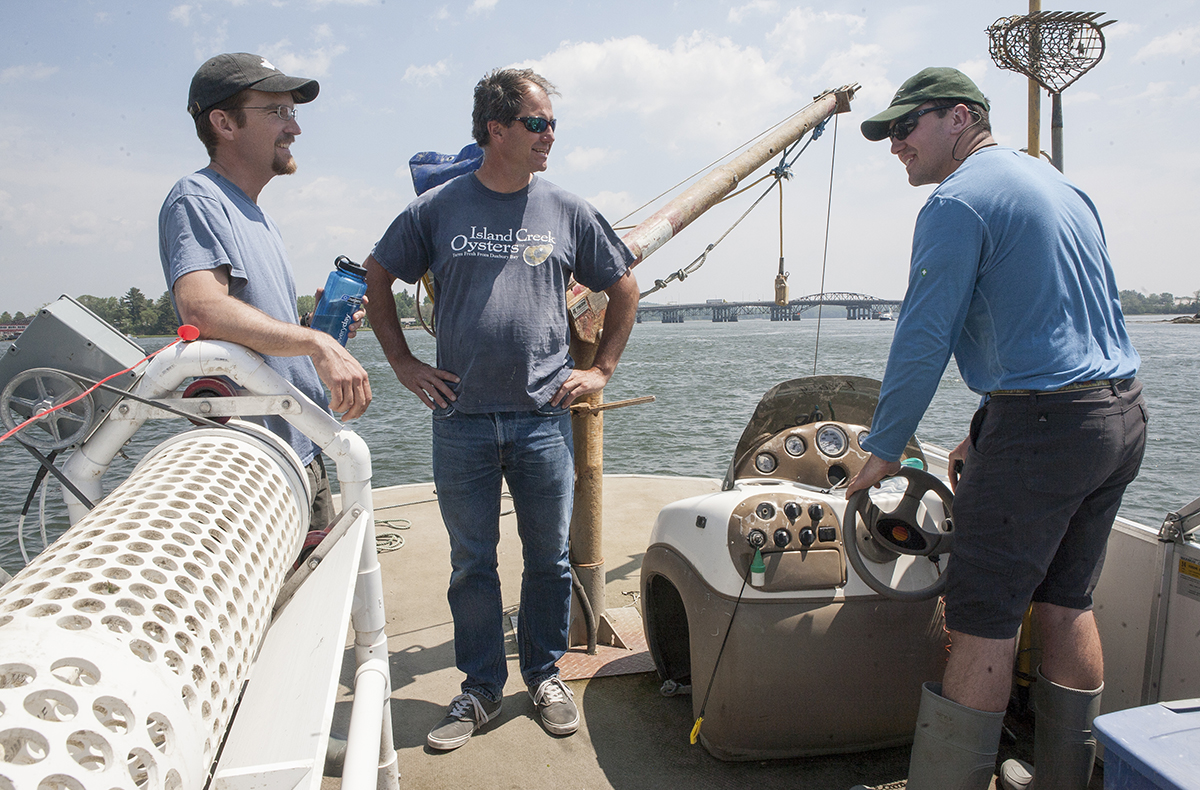
From left: Jay Baker, Skip Bennett from Island Creek Oysters, and Shane Conlin from Pearl Oyster Co. Photo by Olga Khvan.
Then there is the simple issue of supply and demand. Despite the influx of new oyster farmers over the past 15 years, Rheault says that Europe, Asia, and China in particular continue to gobble up the country’s best seafood at an alarming rate, something that was the focus of Paul Greenberg’s latest book, American Catch: The Fight for Our Local Seafood.
“Whoever is willing to spend the most money on the best seafood is going to get it,” Rheault says. “And when the price of fish doubles, which a lot of prognosticators at the World Bank and other experts are predicting, Americans are going to stop eating seafood and we’re going to send it all over to China, Europe, and Japan. It’s expensive to fly these rocks across the planet, but there’s already a market there.”
Not all experts are quite as cynical though. Farmers like Baker and Bennett say they remain vigilant about climate change, ocean acidification, pollution, and even their swelling, cheaper competition from the south, but they’re idealistic regarding the industry’s immediate future. When I met up with Jay to explore his expanding territory in Great Bay, it was the kind of beautiful, placid day that makes you want to swear off the drudgery of office life. Bald eagles were perched overhead and chef Jeremy Sewall was shucking the occasional Fat Dog oyster, “testing” (and sharing) for his menu at the new Row 34 outlet in Portsmouth.

Photo by Olga Khvan.
Skip Bennett was also on board, researching potential spots for his growing Island Creek empire. Besides his original territory in Duxbury, Bennett is also starting to harvest his new Aunt Doddy oysters in Plymouth, not far from the family home where his (you guessed it!) Aunt Doddy once lived. Despite the treacherous winter, Bennett says the last two summers have proven to be ideal oyster weather, an encouraging sign that influenced his recent 10-acre purchase.
Echoing what Rheault said when he compared the boutique oyster market to categories like fine wine and craft beer, Bennett painted a rosy picture of the bivalve’s seemingly endless upward trajectory.
“Oysters used to be so abundant that there was an oyster bar on every street corner in every metropolitan city and it just became a part of our history and culture,” Bennett says. “Now they’re becoming bountiful again, maybe not at the level that they used to be, but we’re definitely experiencing an oyster renaissance. And yeah, I predict there will once again be an oyster bar in every neighborhood in every major city.”

